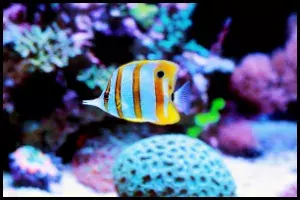Yes, that would be the safest answer to give, due to their possibility to attack coral being at best 50/50 odds. The odds can increase or decrease depending on the type of coral you keep, the amount you feed, the size of your aquarium, and more. Let's take a deep dive into what we can do to better determine their reef compatibility.
-
Feeding Frequency and Amount
- Feeding your fish often and in large amounts will help reduce the chances of your Copperband snacking on your coral.
-
Food Competition
- Often the Copperband butterfly is out-competed for its food source.
- These fish tend to be very shy and will not feed aggressively.
- These fish also might reduce the amount of time outside of cover if you have to many large fish in the fish tank.
- All of these factors could cause your butterfly to go hungry and cause him to snack on your coral while nobody is looking.
-
Coral With Flowing Branches or extensions
- Some corals are more likely to be eaten than others. Generally, stay away from soft coral if possible, but sometimes they can even co-exist with soft coral.
-
Individual Fish's Personality
- Every fish has their own unique personality and some of them just have an absolute designer to eat coral.
- These fish at times have lived in the oceans for years and have developed their on habits, traits, and behaviors. You will likely be unable to change these.
- Be sure to closely monitor your fish and catch his nipping behaviors early.
- If your Copperband has been eating or coral consistently you should just remove them and try to trade it back to your local fish store.
Copperband Butterfly is most compatible with small Stone Polyp Coral (SPS) or Large Stoney Polyp Coral (LPS). This is due to the lack of movement these corals have in the water. In the wild, these fish normally pick at inverts like small crustaceans, copepods, and small anemones. So movement will entice the fish to believe the coral is prey. They can happen with some soft corals that flow in similar ways to the anemone.
You should remember that not all SPS and LPS coral are immune to being prey, I am just speaking in general terms. Some SPS have little feeder polyps which might still trigger the fish's feeding instinct. Every coral is different and might cause a different response to each fish, so a lot of it is a game of chance.
Back to top
Common Coral Victims To The Copperband Butterfly
-
Gorgonians: Gorgonian corals, also known as sea fans, are soft corals with a branching, fan-like structure. Some Copperband butterflies might nibble on the polyps of gorgonians, especially if the gorgonian polyps are extended and resemble potential prey.
-
Tube Corals (Tubastrea sp.): Tube corals have long, tubular polyps that extend at night to feed. Their appearance might attract the attention of Copperband butterflies, particularly if they mistake the polyps for small prey.
-
Fleshy LPS Corals: While Large Polyp Stony (LPS) corals are generally less likely to be targeted by Copperband butterflies, certain fleshy LPS corals with extended tentacles might attract their attention. Examples include open-brain corals (Trachyphyllia) and torch corals (Euphyllia).
-
Ricordea and Discosoma Mushrooms: Some reports suggest that Copperband butterflies might occasionally nip at mushroom corals, especially if they resemble small invertebrates.
-
Soft Corals: Copperband butterflies have been known to occasionally nip at soft corals, especially if they are stressed or not receiving a varied diet. Soft corals with fleshy, exposed polyps might be more susceptible to their curiosity. Examples of soft corals that could be targeted include certain varieties of leather corals (Sarcophyton sp.) and toadstool corals (Sarcophyton sp.).
-
Polyp Extension Corals: Some Copperband butterflies might be attracted to the extended polyps of corals such as certain species of Dendronephthya (carnation corals) and other similar corals. The long, feathery polyps might trigger their feeding behavior.
-
Zoanthids: While not as common, there have been reports of Copperband butterflies occasionally nipping at zoanthid polyps. This might occur if the butterfly is unable to find sufficient natural food sources.
-
Elegance Coral (Catalaphyllia jardinei): This large-polyp stony coral is known for its long, flowing tentacles that are attractive to some butterflyfish, including Copperbands. However, not all Copperbands will show an interest in this coral.
-
Xenia Corals (Xenia spp.): Xenia corals are known for their rhythmic pulsing motion, which can attract the attention of fish. Copperband butterflies might occasionally peck at the polyps of Xenia corals, especially if they mistake the movement for potential prey.
-
Euphyllia Corals: Certain species of Euphyllia corals, such as frogspawn corals and hammer corals, could potentially be nipped by Copperband butterflies. The long, flowing tentacles of these corals might attract the fish's attention.
-
Ruffled Corals (Duncanopsammia spp.): Also known as whisker corals or duncans, these LPS corals have long and flowing tentacles that can capture the attention of curious fish like Copperband butterflies.
-
Sinularia Leather Corals: Some species of Sinularia leather corals have exposed polyps that Copperband butterflies could potentially investigate.
-
Sun Corals (Tubastrea spp.): These corals have large, fleshy polyps that extend to capture food at night. The appearance and movement of the polyps might attract the attention of Copperband butterflies.
-
Bubble Corals (Plerogyra spp.): While Copperband butterflies are less likely to target these corals, the large and textured polyps of bubble corals could potentially be investigated.
In conclusion
Remember that while the risk of Copperband butterflyfish actively preying on corals is generally low, individual behavior can vary. Being proactive and attentive to your fish's behavior and dietary needs will help you maintain a harmonious and thriving reef aquarium environment. If you want to read more about the Copperband Butterfly read more here.
Back to top


